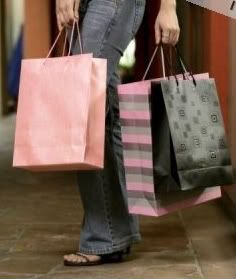Knowing Your Poison, Part 2
Not everyone has an addictive personality. Sometimes it’s just a bit of a weakness for, say, shoes, handbags, or bargain-hunting. But whatever it is, it’s healthy to be aware of it.
If, however, you do find you’re spending in an addictive way in an unhealthy area and you want to look into getting some help, I myself found one particular 12-step program to be invaluable--and free! Here’s a list of 12-step groups, and there are said to be over 100 different ones now.
There’s even a Debtor’s Anonymous which helped friends of mine tremendously. I feel like I’d be remiss not to mention these programs, because I found support, solace, and community there. You probably don’t need one, but if you ever do, just know that they are there. Look them up online or in your phone book and reach out.
A Bit of Therapy for Retail Therapy
Now, on to Retail Therapy, which can feel quite therapeutic at the time but isn’t really therapy, and can ultimately cost way more than therapy.
I found that even though I never had much disposable income I did three rather compulsive things when shopping.
1. One-for-you, two-for-me. If I was buying gifts, for Christmas or whatever, and I was in a store spending money, I’d have my credit card out and I’d buy one for you and two (or three...) for me. It was as if once I got started, I couldn’t stop.
2. The bargain-binge. I’d buy stuff just because it was cheap. Even if it didn’t fit particularly well or I didn’t like the colour—hey, it was a bargain.
3. The grocery-grab-all. I couldn’t buy only one of something, especially if it was on sale. If one box of Cheerios was 10 cents off, I’d snatch up two or three of them, even if I couldn’t possibly use them all before the expiration dates.
Here are a few remedies I use now for each of these:
1. One-for-you. When buying gifts, make a list of exactly what you’re going to look for and note what you’ll spend for each item. Leave the credit (and debit) cards at home and take only the amount of cash you need. If you can afford it, allow yourself a few extra dollars to buy yourself something, or, move on to number two…
2. The tuck-away. It never occurred to me that if I’d avoided doing the bargain-binge a few times, I actually could’ve saved up to buy myself something nice, something I actually wanted or needed. Take an envelope and put $5 or $10 in it each week. Save that money for a few months and then buy yourself a quality item you really do want.
3. Get a plan. Make a grocery list and stick to it. Don’t impulse buy and don’t shop when you’re hungry. Again, leave your credit and debit cards at home and take only the cash you need to do your shopping. If you reach for more than one of an item, evaluate to make sure you really need more than one.
Next time: Overcoming the fear of leaving the plastic behind.
Sunday, October 26, 2008
Saturday, October 25, 2008
Principle #1: Know Your Poison
Know Your Poison

I have an addictive personality. When I sought help for this problem back in 1996, I was told that addiction is "a disease of more." For a lot of us, there is something that always leaves us wanting more, whether it's chocolate, alcohol, gambling, sex, playing the lotto, online gaming, pills, drugs, online chatrooms, Blythe dolls, driving too fast, shoes, Häagen-Dazs or plain old shopping.
You know the thing -- you get excited thinking about doing the thing, and during the preparation for the thing. It gets your endorphins going a bit, and doing the thing itself helps you let go of the worries, concerns, and anxieties of your day-to-day life. You lose yourself in it for awhile--just a little while.

Whether the thing is a healthy escape (or at least not terribly harmful) is usually apparent afterward, when it's possible for guilt, shame and remorse to set in.
Not sure? Ask yourself these questions (yes, they are hard!) and answer honestly.
1. Does the thing impact your mental, emotional, physical, or financial health in negative ways?
3. Do you ever hide the extent of this activity from other people?
2. Is it making your life unmanageable?
I anticipate that as economic times get harder, more and more of us are going to turn to our activities of choice for comfort, to dull the pain of economic reality and the hard times we're facing. Of course, this will likely make our own economic realities harder.
I know, because I've done it. Back in 1995 I had buried myself in a 'drug of choice' hole that was so deep -- financially, emotionally, mentally, and physically -- that it was unimaginable that I'd ever be able to crawl (much less climb) out of it.
Hence we begin the journey of this blog. Most importantly, today:
1. I keep "the disease of more" at bay,
2. I live within my means, and
3. I am free of the fear of financial insecurity.
Next I'll begin sharing with you the concrete things I've done to achieve those three vital accomplishments.
Don't worry, this isn't a blog just for addicts, alcoholics, shopoholics, or any other kind of -ics! It's just good to know what your weakness(es) are when you begin to look at your spending patterns--if you have any weaknesses, and I'm certainly not suggesting that all of us do. But remember that when it comes to money, it's not just what you spend your money on, but when and how you spend, because many of us can be emotionally-driven spenders, at times, without even realizing it. Much more on this to come!

Next time: Therapy for retail therapy.

I have an addictive personality. When I sought help for this problem back in 1996, I was told that addiction is "a disease of more." For a lot of us, there is something that always leaves us wanting more, whether it's chocolate, alcohol, gambling, sex, playing the lotto, online gaming, pills, drugs, online chatrooms, Blythe dolls, driving too fast, shoes, Häagen-Dazs or plain old shopping.
You know the thing -- you get excited thinking about doing the thing, and during the preparation for the thing. It gets your endorphins going a bit, and doing the thing itself helps you let go of the worries, concerns, and anxieties of your day-to-day life. You lose yourself in it for awhile--just a little while.

Whether the thing is a healthy escape (or at least not terribly harmful) is usually apparent afterward, when it's possible for guilt, shame and remorse to set in.
Not sure? Ask yourself these questions (yes, they are hard!) and answer honestly.
1. Does the thing impact your mental, emotional, physical, or financial health in negative ways?
3. Do you ever hide the extent of this activity from other people?
2. Is it making your life unmanageable?
I anticipate that as economic times get harder, more and more of us are going to turn to our activities of choice for comfort, to dull the pain of economic reality and the hard times we're facing. Of course, this will likely make our own economic realities harder.
I know, because I've done it. Back in 1995 I had buried myself in a 'drug of choice' hole that was so deep -- financially, emotionally, mentally, and physically -- that it was unimaginable that I'd ever be able to crawl (much less climb) out of it.
Hence we begin the journey of this blog. Most importantly, today:
1. I keep "the disease of more" at bay,
2. I live within my means, and
3. I am free of the fear of financial insecurity.
Next I'll begin sharing with you the concrete things I've done to achieve those three vital accomplishments.
Don't worry, this isn't a blog just for addicts, alcoholics, shopoholics, or any other kind of -ics! It's just good to know what your weakness(es) are when you begin to look at your spending patterns--if you have any weaknesses, and I'm certainly not suggesting that all of us do. But remember that when it comes to money, it's not just what you spend your money on, but when and how you spend, because many of us can be emotionally-driven spenders, at times, without even realizing it. Much more on this to come!

Friday, October 24, 2008
Welcome to the Money Shot
Many of you know me as Obsidian Kitten, and I now welcome you to this side project, which I have decided to call The Money Shot. With the rollercoastering economy (what, you hadn't noticed?) it occurs to me to share some of my experiences (for better and for worse) garnered during twenty years of living on a financial shoestring.
Look. I graduated magna cum laude from Yale, so you'd think I'd have top-notch earning potential. What I seem to have instead is top-notch resourcefulness potential. (Here's a list of jobs I've had, just to dazzle you with the bizarre variety of ways I've earned money.)
The past two decades have involved a great deal of trial and error (probably more of the latter) but a few lessons learned -- because somehow I've managed to survive the NYC economy with jobs primarily in the non-profit sector, earning on average (I'd guess) about $20,000/year (15 870 Euros). Currently that's an unbelievable margin of nearly 150% over the 2008 US poverty threshold. (As if 2 people could live on $14,ooo a year.)

Anyway, I will discuss topics such as:
~ the liklihood of living in a box over a steam grate
~ where to get totally free prescriptions
~ how I learned to curb my shopping compulsions ("but it's on sale!" and "surely three are better than one!")
~ what it was like to apply for food stamps
~ where I've found delectable and occassionally designer garb super-cheap
~ ways I save cash without exerting much energy (I'm lazy, so no coupon -clipping here)
~ and much, much more.
So please tune in again as we begin our journey with a crash course in how I landed in NYC making $225/week at a major Manhattan Museum--hey, I work on Madison Avenue, y'all!--and trying to pay rent on a nice Hoboken apartment. (Well, it was a very nice apartment, just not on the nice side of Hoboken...)
Look. I graduated magna cum laude from Yale, so you'd think I'd have top-notch earning potential. What I seem to have instead is top-notch resourcefulness potential. (Here's a list of jobs I've had, just to dazzle you with the bizarre variety of ways I've earned money.)
The past two decades have involved a great deal of trial and error (probably more of the latter) but a few lessons learned -- because somehow I've managed to survive the NYC economy with jobs primarily in the non-profit sector, earning on average (I'd guess) about $20,000/year (15 870 Euros). Currently that's an unbelievable margin of nearly 150% over the 2008 US poverty threshold. (As if 2 people could live on $14,ooo a year.)

Anyway, I will discuss topics such as:
~ the liklihood of living in a box over a steam grate
~ where to get totally free prescriptions
~ how I learned to curb my shopping compulsions ("but it's on sale!" and "surely three are better than one!")
~ what it was like to apply for food stamps
~ where I've found delectable and occassionally designer garb super-cheap
~ ways I save cash without exerting much energy (I'm lazy, so no coupon -clipping here)
~ and much, much more.
So please tune in again as we begin our journey with a crash course in how I landed in NYC making $225/week at a major Manhattan Museum--hey, I work on Madison Avenue, y'all!--and trying to pay rent on a nice Hoboken apartment. (Well, it was a very nice apartment, just not on the nice side of Hoboken...)
Subscribe to:
Comments (Atom)



